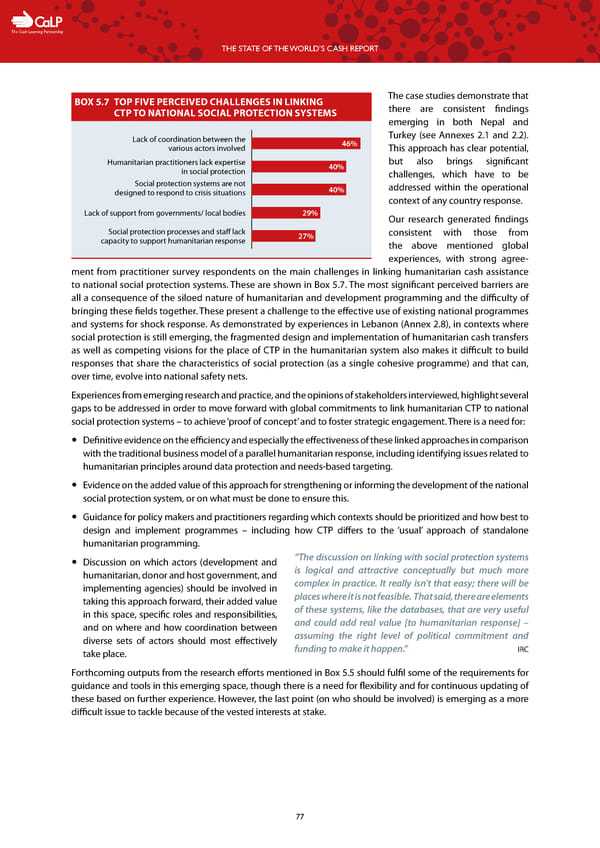C The Cash Learning Partnership THE STATE OF THE WORLD’S CASH REPORT BOX 5.7 TOP FIVE PERCEIVED CHALLENGES IN LINKING The case studies demonstrate that CTP TO NATIONAL SOCIAL PROTECTION SYSTEMS there are consistent findings emerging in both Nepal and Lack of coordination between the Turkey (see Annexes 2.1 and 2.2). various actors involved 46% This approach has clear potential, Humanitarian practitioners lack expertise 40% but also brings significant in social protection challenges, which have to be Social protection systems are not 40% addressed within the operational designed to respond to crisis situations context of any country response. Lack of support from governments/ local bodies 29% Our research generated findings Social protection processes and staff lack 27% consistent with those from capacity to support humanitarian response the above mentioned global experiences, with strong agree- ment from practitioner survey respondents on the main challenges in linking humanitarian cash assistance to national social protection systems. These are shown in Box 5.7. The most significant perceived barriers are all a consequence of the siloed nature of humanitarian and development programming and the difficulty of bringing these fields together. These present a challenge to the effective use of existing national programmes and systems for shock response. As demonstrated by experiences in Lebanon (Annex 2.8), in contexts where social protection is still emerging, the fragmented design and implementation of humanitarian cash transfers as well as competing visions for the place of CTP in the humanitarian system also makes it difficult to build responses that share the characteristics of social protection (as a single cohesive programme) and that can, over time, evolve into national safety nets. Experiences from emerging research and practice, and the opinions of stakeholders interviewed, highlight several gaps to be addressed in order to move forward with global commitments to link humanitarian CTP to national social protection systems – to achieve ‘proof of concept’ and to foster strategic engagement. There is a need for: — Definitive evidence on the efficiency and especially the effectiveness of these linked approaches in comparison with the traditional business model of a parallel humanitarian response, including identifying issues related to humanitarian principles around data protection and needs-based targeting. — Evidence on the added value of this approach for strengthening or informing the development of the national social protection system, or on what must be done to ensure this. — Guidance for policy makers and practitioners regarding which contexts should be prioritized and how best to design and implement programmes – including how CTP differs to the ‘usual’ approach of standalone humanitarian programming. — Discussion on which actors (development and “The discussion on linking with social protection systems humanitarian, donor and host government, and is logical and attractive conceptually but much more implementing agencies) should be involved in complex in practice. It really isn’t that easy; there will be taking this approach forward, their added value places where it is not feasible. That said, there are elements in this space, specific roles and responsibilities, of these systems, like the databases, that are very useful and on where and how coordination between and could add real value [to humanitarian response] – diverse sets of actors should most effectively assuming the right level of political commitment and take place. funding to make it happen.” IRC Forthcoming outputs from the research efforts mentioned in Box 5.5 should fulfil some of the requirements for guidance and tools in this emerging space, though there is a need for flexibility and for continuous updating of these based on further experience. However, the last point (on who should be involved) is emerging as a more difficult issue to tackle because of the vested interests at stake. 77
 The State of the World's Cash | Full Report Page 78 Page 80
The State of the World's Cash | Full Report Page 78 Page 80